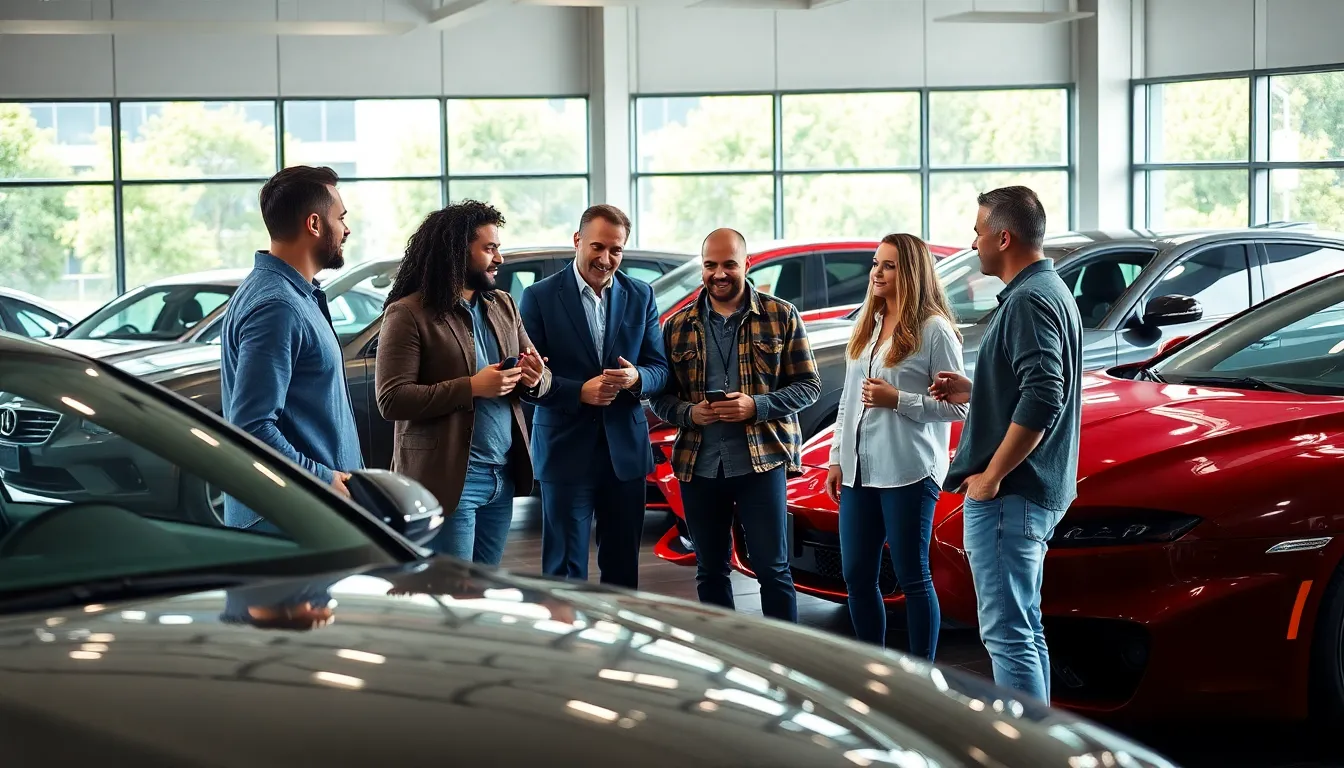In a world where car enthusiasts seek the perfect ride, building a dream car website can be a game-changer. It’s not just about showcasing vehicles; it’s about creating a community where passion meets innovation. From sleek designs to user-friendly interfaces, every element plays a crucial role in attracting visitors and keeping them engaged.
Imagine a platform where users can explore custom builds, share their experiences, and connect with others who share their love for cars. This article dives into the essential steps to create that dream car website, offering insights on design, functionality, and content that resonates with fellow auto aficionados. Whether you’re a seasoned developer or a beginner, the journey to crafting an inspiring online space starts here.
Table of Contents
ToggleOverview of Building Your Dream Car Website
Building a dream car website involves multiple elements that cater to both aesthetics and functionality. A well-structured design enhances user experience, making navigation intuitive and enjoyable. Key aspects include:
- Responsive Design: Ensures optimal viewing on various devices, including desktops, tablets, and smartphones.
- User-Friendly Interface: Focus on clear menus, easy access to content, and simplified search functions that facilitate user engagement.
- Engaging Content: Offer diverse content types, such as articles, videos, and forums, to attract car enthusiasts and keep them returning.
- Community Features: Incorporate forums and social media integration to encourage discussions and interactions among users.
- Customization Options: Allow users to share their builds and modifications, fostering a sense of ownership and personal connection.
- SEO Optimization: Use relevant keywords in content to improve search engine rankings and visibility, drawing more traffic to the site.
By combining these elements, builders create a robust platform that not only showcases vehicles but also nurtures a vibrant community focused on shared automotive passions.
Planning Your Dream Car Website

Planning a dream car website requires strategic thinking and clear intent. Defining the audience and establishing goals ensures the site meets user needs while achieving business objectives.
Defining Your Target Audience
Defining the target audience involves identifying specific groups interested in car culture. Car enthusiasts, casual drivers, and prospective buyers represent key demographics.
- Demographics: Focus on age ranges, gender, income levels, and geographic locations of your audience. Understanding these factors assists in catering to preferences and needs.
- Interests: Identify interests such as classic cars, performance vehicles, or electric cars. Tailoring content around these interests keeps the audience engaged.
- Engagement Level: Determine whether the audience seeks casual browsing, in-depth technical discussions, or social interactions. This helps in designing user experience features and forum types.
Setting Goals and Objectives
Setting clear goals and objectives shapes the website’s purpose. Defining these parameters ensures alignment with user expectations and business aspirations.
- Traffic Goals: Establish specific traffic targets, such as attracting 5,000 unique visitors per month within the first six months. Use analytics tools to track progress and refine strategies.
- Engagement Metrics: Aim for engagement metrics like average session duration or pages per visit. This indicates user interest and content effectiveness.
- Community Growth: Focus on building a community by targeting a specific number of forum posts or user registrations in designated timeframes. Encourage user involvement to create a dynamic platform.
Strategically defining the audience and setting measurable goals will lay a solid foundation for developing a successful dream car website.
Essential Features for Your Dream Car Website
In building a dream car website, essential features enhance user experience and foster community engagement. Incorporate functionalities that attract and retain users effectively.
User-Friendly Navigation
User-friendly navigation keeps visitors engaged and facilitates easy exploration. Clear menus and intuitive layouts guide users to important sections like car listings, forums, and blogs. Implement breadcrumb trails to enhance usability, allowing users to track their location within the site’s structure. Prioritize mobile responsiveness, ensuring navigation remains seamless across devices. Search functionality should also be available, enabling users to find specific content quickly.
High-Quality Visuals
High-quality visuals captivate visitors and significantly impact user experience. Use professionally taken photographs and high-resolution images of vehicles, showcasing them from multiple angles. Incorporate videos, such as 360-degree views or test drives, to engage users further. Consistent branding with a cohesive color palette and typography also enhances the visual appeal. Ensure images are optimized for fast loading times, improving overall site performance.
Interactive Tools
Interactive tools elevate user engagement on a dream car website. Include vehicle customization simulators, allowing users to design their dream cars visually. Offer a feature for users to compare different models side by side, helping them make informed decisions. Implement a forum or chat tool for real-time discussions, fostering community interaction. Additionally, provide calculators for financing or insurance estimates, assisting users in planning their purchases effectively.
Choosing the Right Platform
Selecting the right platform for a dream car website is vital for functionality and growth. The choice impacts design flexibility, user experience, and overall site performance.
Website Builders vs. Custom Development
Website builders like Wix, Squarespace, and WordPress offer templates and drag-and-drop features, making setup easy without coding skills. These platforms provide quick solutions with various customization options, perfect for those needing speed. However, complexities in specific features may arise, limiting functionality for advanced needs.
Custom development involves hiring skilled developers to create a tailored platform. This approach permits complete design freedom and the addition of unique features. Custom sites can scale with increasing traffic and maintain high performance. While this option requires a higher budget and time investment, it results in a unique and fully integrated user experience that adheres to specific requirements.
Comparing Different Platforms
| Platform | Key Features | Cost Range | Best For |
|---|---|---|---|
| WordPress | Extensive plugins, customizable themes | Free, with paid options | Blogs and e-commerce sites |
| Wix | User-friendly interface, advanced design tools | $14 – $49 per month | Small businesses and portfolios |
| Squarespace | Beautiful templates, integrated e-commerce | $12 – $40 per month | Creative portfolios and stores |
| Shopify | Robust e-commerce capabilities, easy payment | Starts at $29 per month | Online stores |
| Custom Development | Fully tailored solutions, unique functionalities | Varies widely; $5,000+ | Specialized requirements |
Choosing the right platform involves assessing individual needs and long-term goals. Evaluate factors like budget, design requirements, and future scalability to select the ideal foundation for a dream car website.
Designing Your Dream Car Website
Designing a dream car website involves careful consideration of aesthetics and functionality. A well-thought-out design enhances user experience and engagement.
Selecting a Suitable Theme
Selecting a suitable theme plays a crucial role in establishing the website’s identity. Themes should reflect automotive interests and align with branding. Choose a responsive theme optimized for speed and usability. Look for options with customizable layouts to showcase vehicles effectively. Consider themes that support multimedia content, allowing users to engage with videos and images seamlessly. Themes often offer built-in SEO features to improve visibility, so prioritize those that facilitate search engine optimization.
Importance of Responsive Design
Responsive design is essential for ensuring optimal viewing across devices. A responsive website automatically adjusts layout and content based on screen size, enhancing user experience on smartphones, tablets, and desktops. Prioritizing responsive design reduces bounce rates as users can navigate the site easily regardless of their device. Google also favors mobile-friendly sites, impacting search rankings positively. Regularly test responsiveness to address any issues, ensuring consistent access to content for all users.
Building a dream car website is an exciting journey that requires careful planning and execution. By focusing on user experience and community engagement, it’s possible to create a platform that not only showcases vehicles but also connects enthusiasts. Prioritizing responsive design, engaging content, and interactive features can significantly enhance user satisfaction.
Choosing the right platform and theme plays a crucial role in achieving desired functionality and aesthetics. Regularly testing and optimizing for SEO will further boost visibility and attract a wider audience. With dedication and creativity, anyone can transform their vision into a thriving online space for car lovers.


